Adam Pritchett: Stitch insects
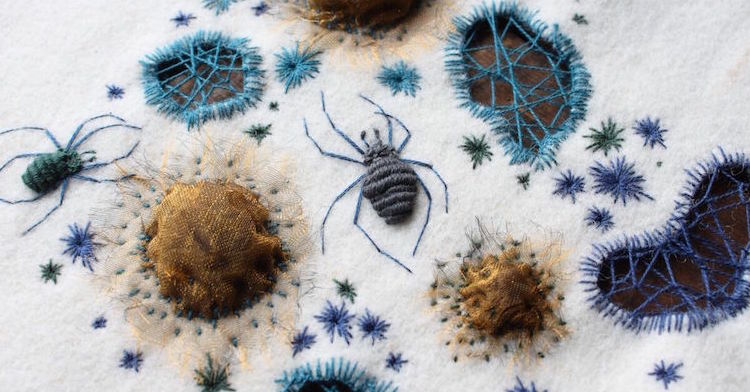
Adam Pritchett is a British artist who studied Fine Arts at Coventry University focusing on textile sculptural forms, which developed into embroidery after graduating.
His most notable achievement and personal highlight was appearing on Kirstie Allsopp’s Handmade Christmas in 2016, embroidering a Christmas stocking.
In this interview, Adam takes us on his artistic journey. We discover what led him to work with thread, why the natural world inspires him and the direction his art may take in the future.
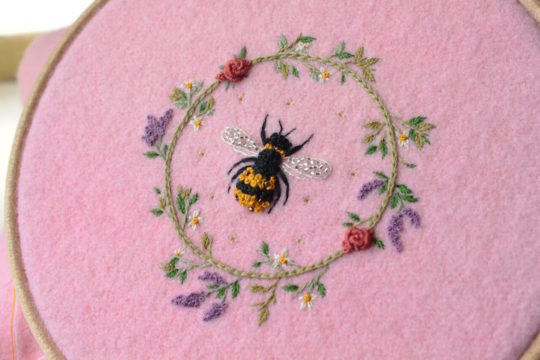
Adam Pritchett, Queen Bee, 2016
A new beginning
TextileArtist.org: What initially attracted you to textiles as a medium?
Adam Pritchett: I have always had an interest in textiles, I remember making fabric toys and puppets during school holidays with my Grandmother.
I think the real moment that it became a fascination to me was while studying at university and I distinctly recall workshops learning about the structure of fabrics and how they are made and just being enthralled by the way that thread could be woven to create beautiful fabrics.
That is when I learnt to weave, and how to knit and spin yarn, it really was a new beginning for me as a maker.
And, more specifically, how was your imagination captured by stitch?
Once I had begun to learn about how fabrics were constructed I kept extensive sketchbooks full of experiments in all kinds of appliqué, felting, dyeing, etc. and stored them away while I was studying. I’ve always been a collector of things, so filing away all of my experiments was always an enjoyable, cathartic process.
A year or so after graduating I was in a bit of a slump and knew I needed to start making artwork again but didn’t know what, so I dug out my old sketchbooks and dove back into textiles.
Around that same point, I had noticed a number of people on social media accounts that I followed working in embroidery and decided that I needed to teach myself.
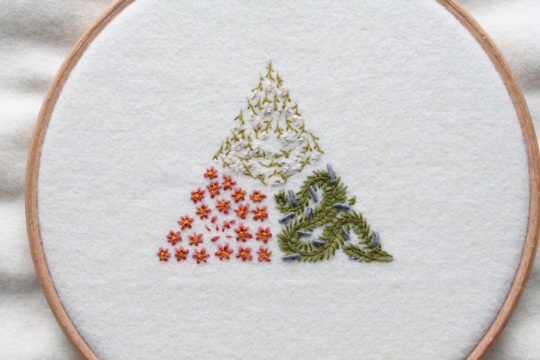
Adam Pritchett, Tryptich of flowers, 2017
What was your route to becoming an artist?
I studied a foundation degree before going to university, and originally began a BA in 3D Design a wonderful contemporary crafts course where I learnt a huge amount of practical techniques and materials, but unfortunately the university I was attending closed the course down after a year being on it.
I was then offered a place on the Fine Arts degree, and from there I have had a slow and meandering path to where I am now. You grow from every experience, and I honestly don’t think that I would make the same kind of work had I had a smoother journey to here and now.
Tell us a bit about your chosen techniques.
The focus of my work is hand embroidery, using traditional methods and stitches in my practice to create contemporary works. I also work with a lot of hand dyed fabrics that I produce myself, often incorporating appliqué and beading in with hand stitching.
I like to build up layers of stitches to create raised effects, without using stump work wires, incorporating a number these techniques has produced some really interesting results and all leads back to how I enjoy experimentation with known methods to create something different.
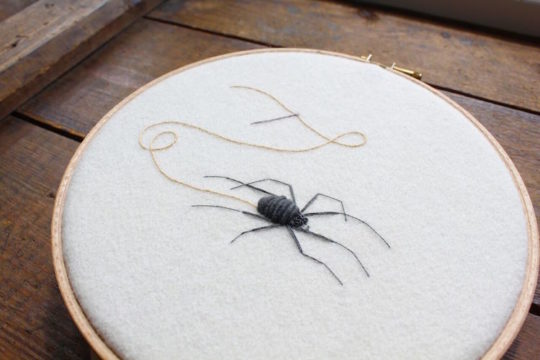
Adam Pritchett, Sewing spider, 2017
Making every opportunity count
How would you describe your work and where do you think it fits within the sphere of contemporary art?
I think that a key theme in my work is that of reconstruction and passing of time. A reoccurring theme of spiders in a series of pieces that I have made have all been based around cutting away at fabric, and weaving lace-like structures similar to webs over the holes to make them complete again. The break down and rebuilding is a subject that keeps coming up in my work, and one that I don’t feel I have finished exploring yet.
My work feels more illustrative than conceptual, and the shows that I have exhibited in have featured alongside mostly illustrators so I suppose I’m not really sure how my work fits in alongside other textile art.
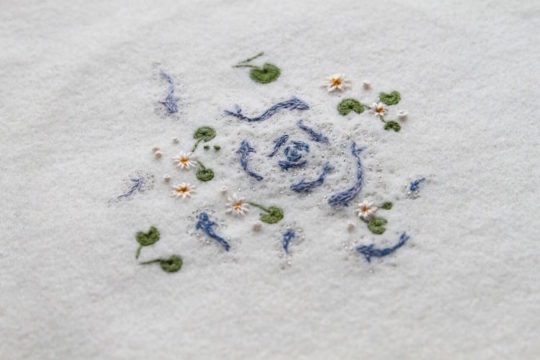
Adam Pritchett, Koi pond, 2016
In my work, I really like the juxtapositions between working in soft materials like fabrics and thread, and the subjects that feature in my work like insects. A common remark about some of my more recognisable works that feature spiders are that of conflicting feeling between visually appealing embroidered stitching, and the realism of spiders on webs which in contrast are a common source of discomfort to many people.
Being self-taught there’s always been an element of making it up as I go along, so I try to just make every opportunity count when one comes along.
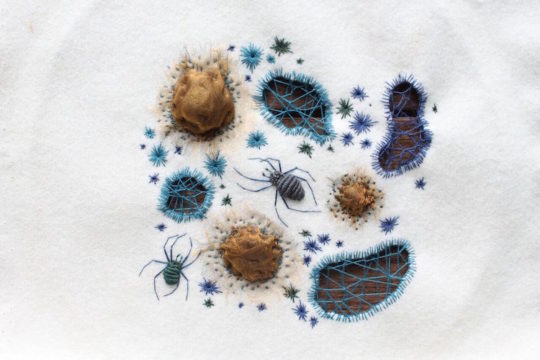
Adam Pritchett, Spiders nest, 2016
Do you use a sketchbook? If not, what preparatory work do you do?
I do have a small sketchbook that I often use to sketch out compositions, and structures for new pieces to test how I think they might visually work. Mainly, I keep visual scrapbooks of images that I collect and curate to help me form ideas for new pieces of work.
My actual preparation before starting an embroidery is quite brief, I draw directly on to my fabric using air erasable pens which fade over a period of time, these allow me to work in a very fast & fluid way meaning a piece of work changes and takes shape as it is made.
It is quite rare for a piece of mine to end anywhere near how it began looking!
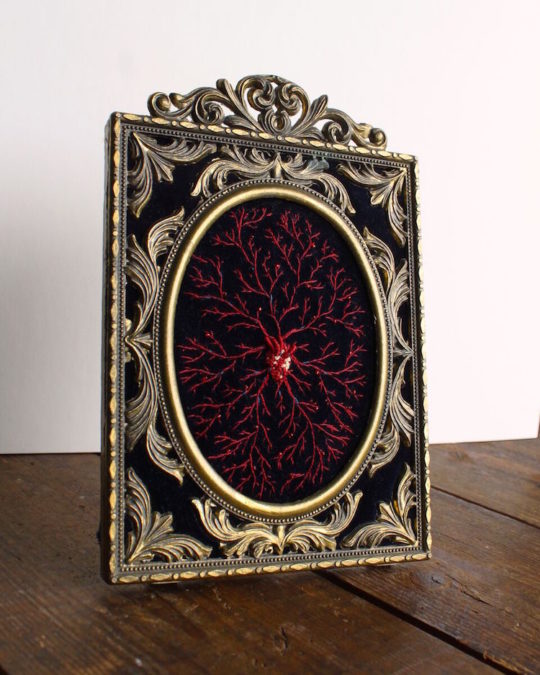
Adam Pritchett, Beating heart, 2017
What environment do you like to work in?
I am very much a sewing nomad, I don’t have a studio space that I work in, although it is something I would love to have in the future. Currently, I stitch wherever I can, and move my sewing box and fabrics around from place to place with me.
I do like a space that I can nest in, and settle down with everything I need around me to just work. I often listen to the radio, or podcasts as they’re non-distracting background noise that I find helps me to focus without any overwhelming silence. I am very much a night owl, it is quite common for me to be so focused that I haven’t realised it’s 1am and I have been working for 6 hours without really moving.
What currently inspires you?
Much of my work has botanical, natural themes, and I am a huge science/nature buff. Documentaries about the natural world always are a huge source of inspiration for me, the recent David Attenborough series Planet Earth II was exactly in my element and I must have watched it all over dozens of times.
I also read as much as I can, and often find an idea is sparked by a fantasy novel that I’ve been reading, and I think that’s where much of the myth and magic themes in my work come from.
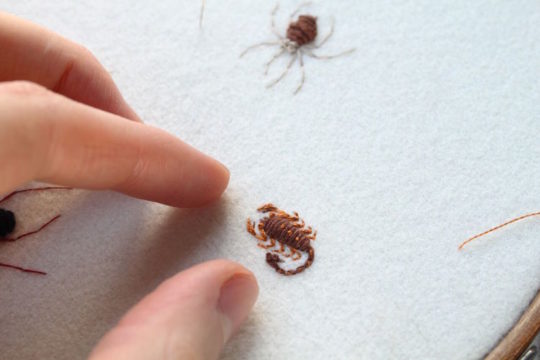
Adam Pritchett, Miniature Scorpion, 2017
The foundation of knowledge
How has your work developed since you began and how do you see it evolving in the future?
Looking back at work made when I first set out compared to now I can see huge changes in terms of technical ability, I am very critical of myself so after a few months when I look back at work I see mistakes and things I would do differently.
But in the future, I hope to form more concept driven work and start to work on larger pieces to branch out and see if aspects I find interesting at a small scale translate when that is challenged.
What advice would you give to an aspiring textile artist?
The best piece of advice I could give to someone looking to work in textiles, learn as much as you possibly can about basics like fabric construction, technical hand stitching methods, dyeing, darning, felting, anything and everything you can sink your teeth into. Once you have the foundations of knowledge about textiles, you can grab that area that you find a special affinity with, and run with it.
You’ll never be a master of all trades, but knowing a little about everything will help you discover your particular interest much faster, I wish someone had told me that and perhaps I’d have found my way to embroidery just a bit faster.
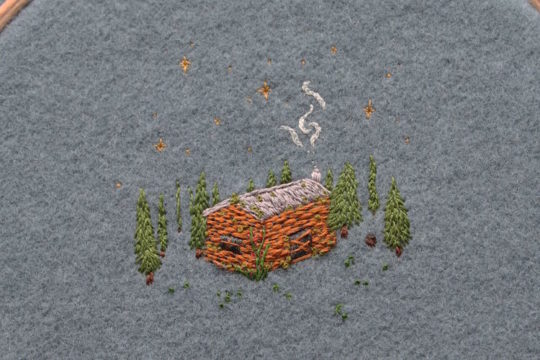
Adam Pritchett, Lonely cabin, 2016
What other resources do you use? Blogs, websites, magazines etc.
I am a big user of social media for artwork, especially Instagram, the arts community on there is the best that I have come across anywhere else. The comments, feedback and instant support that you can always rely on has been key to me feeling comfortable about showing my work to people.
Not to mention the vast numbers of talented textile artists on there just a few of my favourite people that I always check up on to see what new work they’re making are; Lana Crooks, Caitlin McCormack, Jess de Wahls, Sally Hewett, Alaina Varrone, Emillie Ferris.
What piece of equipment or tool could you not live without?
Good quality needles and my thread scissors, I am admittedly one of those people who has about 10 different pairs of scissors and so help the person who uses the wrong pair for the wrong purpose.
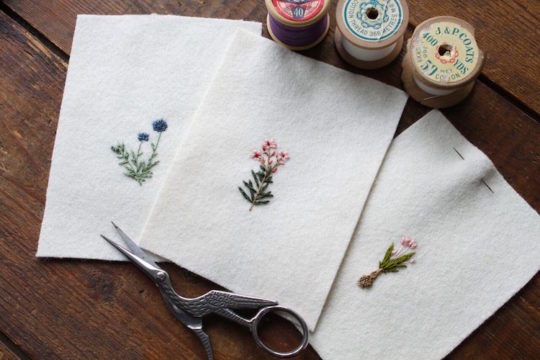
Adam Pritchett, Italian flowers in collaboration with Rhianne Masters, 2017
Do you give talks or run workshops or classes? If so where can readers find information about these?
I recently taught some classes in the basics of hand embroidery, through to designing a more illustrative piece of work, those classes were with the wonderful Hannah & Rosie over at The New Craft House in London.
If I do run any more workshops in the coming year, they would most likely be there again, but currently, I don’t have any further dates set.
New dates would be posted on my website.
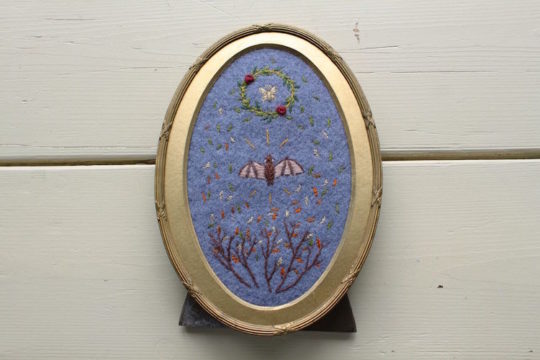
Adam Pritchett, The Chase, 2017
How do you go about choosing where to show your work?
I don’t really show work as often as I’d like, I am a bit of a novice when it comes to contacting galleries about shows. I have been lucky enough to show with the amazing folks at the Light Grey Art Lab a number of times in the US, but I am currently looking at new places to show work.
I live in the Lake District so we’re a little remote from the busy London gallery world!
Where can readers see your work this year?
Camouflage, at Light Grey Art Lab in Minneapolis, U.S.A. from May 26th, 2017.
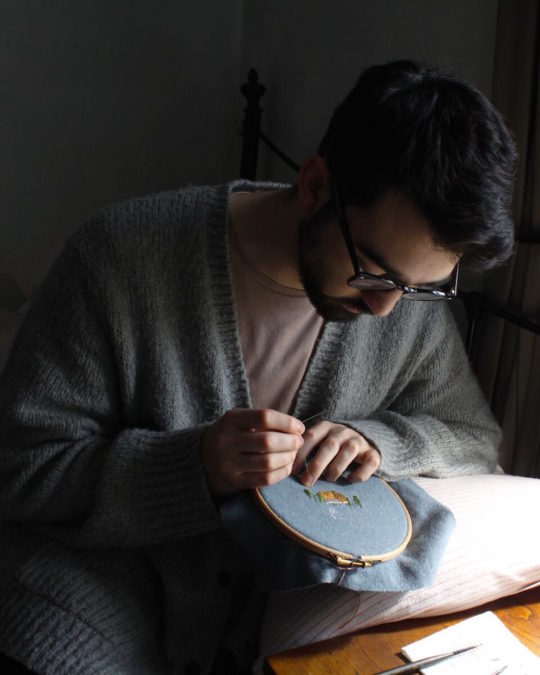
Adam Pritchett, Portrait work in progress
For more information visit: www.apritchett.co.uk or on Instagram.
If you’ve enjoyed this interview why not share it with your friends on Facebook using the button below?
















I really appreciate the skillful, thoughtful, and delicate nature of his work. I especially like the “Beating Heart” piece. I’m always impressed with self-taught artists.